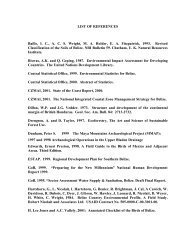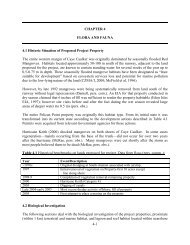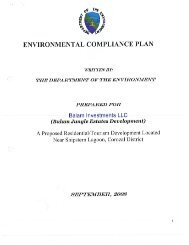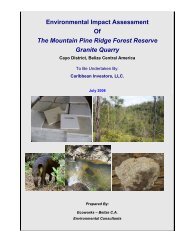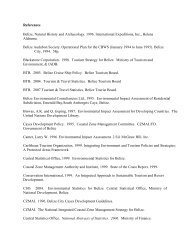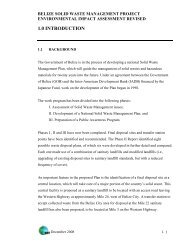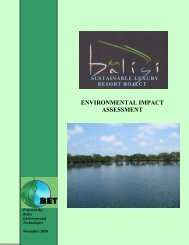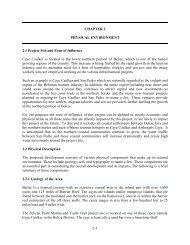Ambergris Caye Belize Resort Development - Department of ...
Ambergris Caye Belize Resort Development - Department of ...
Ambergris Caye Belize Resort Development - Department of ...
Create successful ePaper yourself
Turn your PDF publications into a flip-book with our unique Google optimized e-Paper software.
gasoline and butane) are readily available from the commercial sector. The demand will be<br />
according to the different facilities such as the hotel, restaurants and most importantly the<br />
diesel generators, as well as the maintenance facilities.<br />
64.1 Cooking Fuel<br />
Fuel such as butane and propane used for cooking and refrigeration if necessary will be<br />
stored using the recommended guidelines. Each facility such as the hotel and restaurants<br />
will store these fuels at the back <strong>of</strong> each building with the proper containment measures.<br />
The transportation <strong>of</strong> butane and propane will be the responsibility <strong>of</strong> the supplier, who<br />
will follow the recommended guidelines for the transportation <strong>of</strong> Hazardous Materials.<br />
The supplier will also be responsible for the refilling and/or replacement <strong>of</strong> any faulty or<br />
corroded container. Cylinder will be filled in San Pedro town and taken to the project site<br />
via boat or barge. The cylinders will be <strong>of</strong>floaded at the Basil Jones Municipal pier and<br />
transported to the site.<br />
6.4.2 Fuel Storage and Transportation<br />
Fuel for the project will be transported by a 10,000 gallons fuelling barge to the site. Fuel<br />
will be pumped into the barge at a Fuelling Depot location and taken to the Basil Jones<br />
pier where it will discharge into an awaiting tanker. Proper pumping equipment will be<br />
used but will not be fixed. The tanker will then take the fuel to the site and discharge the<br />
fuel into the respective holding tanks. The handling <strong>of</strong> fuel will follow the standard<br />
protocol for the loading and unloading <strong>of</strong> fuel in the sea. The fuel demand for the<br />
generators <strong>of</strong> this capacity can range anywhere from 79 gallons/hr to 150 gallons/hr. For<br />
this reason, fuel for the generators will be stored in two- 15,000 gallons Above Storage<br />
Tank [AST] contained in a re-enforce concrete containment wall. Fiber glass piping will<br />
be used for the fuel transmission lines. The containment wall will be constructed so as to<br />
hold 110% <strong>of</strong> the volume <strong>of</strong> the tank. This volume will supply the project generators site<br />
and with the necessary fuel needed for development and operation.<br />
The fuel supply will be managed by ABR with the assistance <strong>of</strong> a designated Fuel<br />
Supplier. The installation <strong>of</strong> the AST tanks will be ensured to follow the environmental<br />
clearance process, which requires the application <strong>of</strong> operation <strong>of</strong> a service station, and<br />
follow up inspections by relevant authorities, including DOE and the National Fire Service<br />
(NFS). The transportation <strong>of</strong> fuel will be the responsibility <strong>of</strong> the supplier and ABR, who<br />
will follow recommended guidelines for the transportation <strong>of</strong> Hazardous Materials.<br />
The accidental spill <strong>of</strong> fuel will be avoided as much as possible. An Oil Spill and Fire<br />
Contingency Plan will be developed to address all issues pertaining to spills, leaks and<br />
fires both on the island and at sea. The plan will contain mitigation measures (booms, kits),<br />
clean up processes as well as the required training for safety and health. Additional<br />
information is explained in Chapter 8.<br />
6-4




